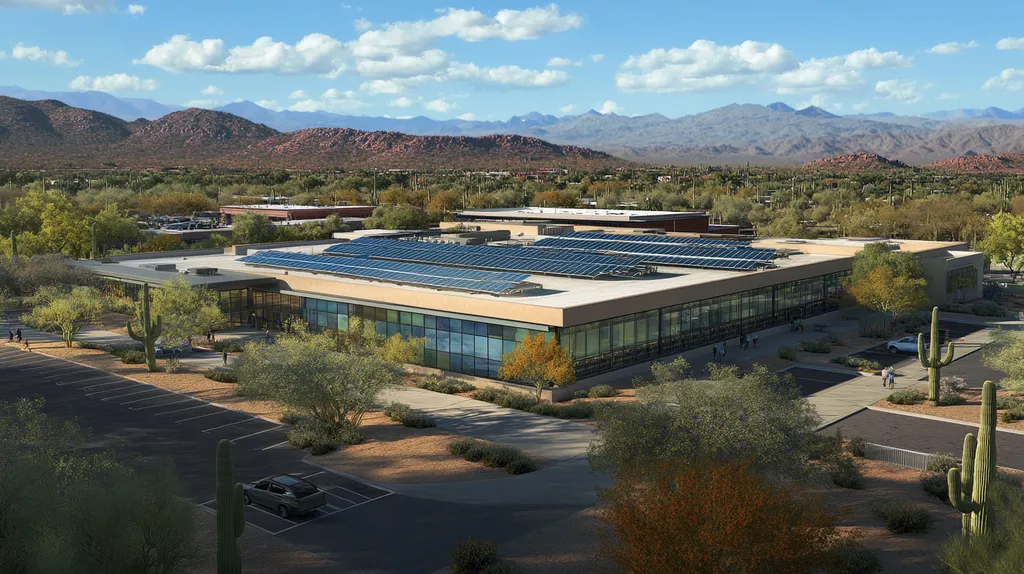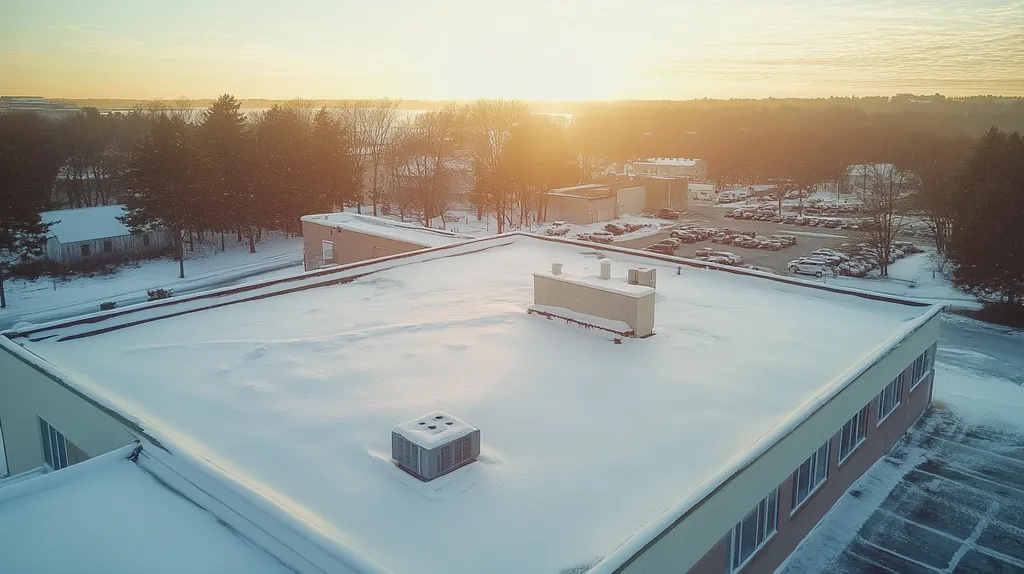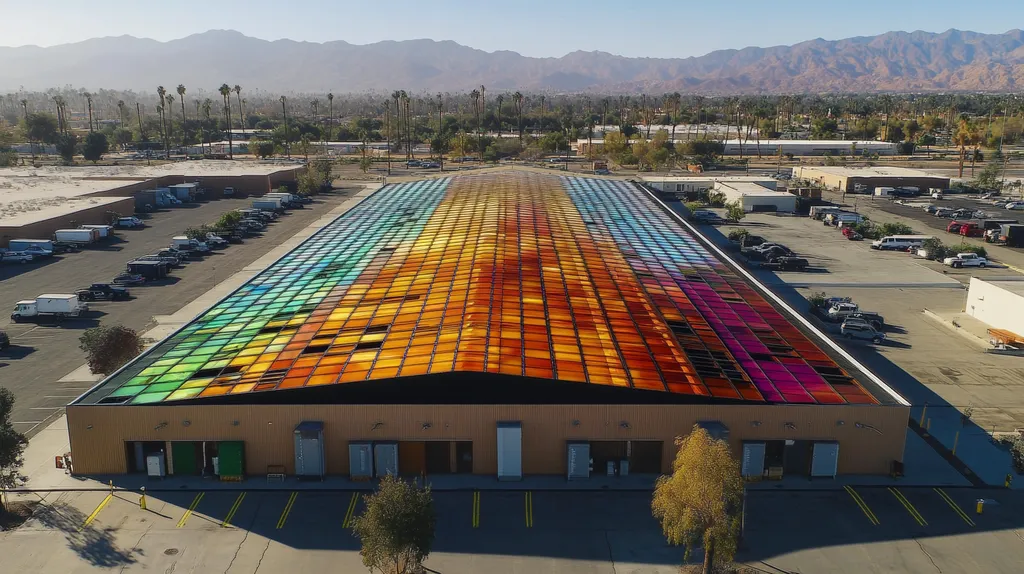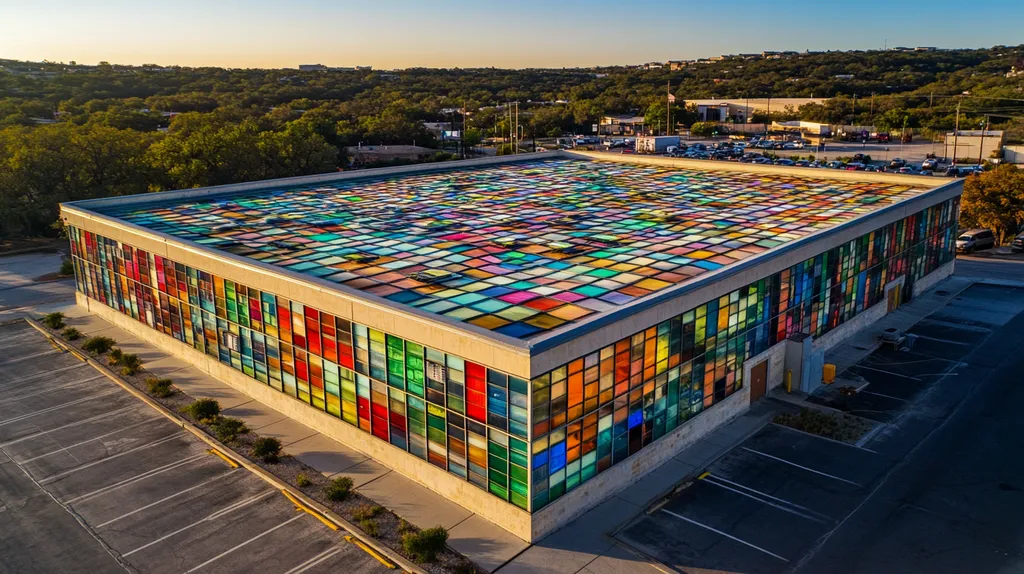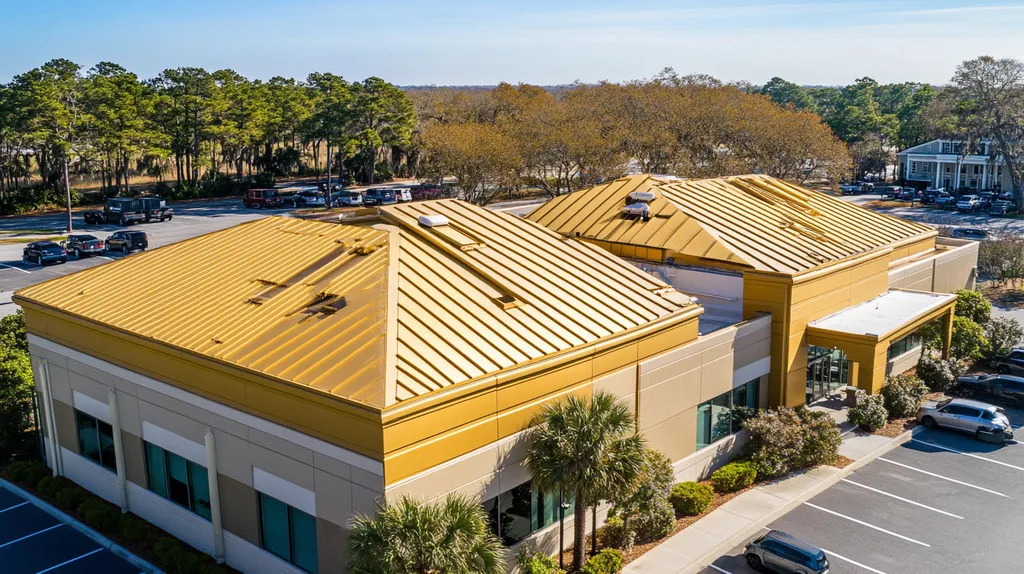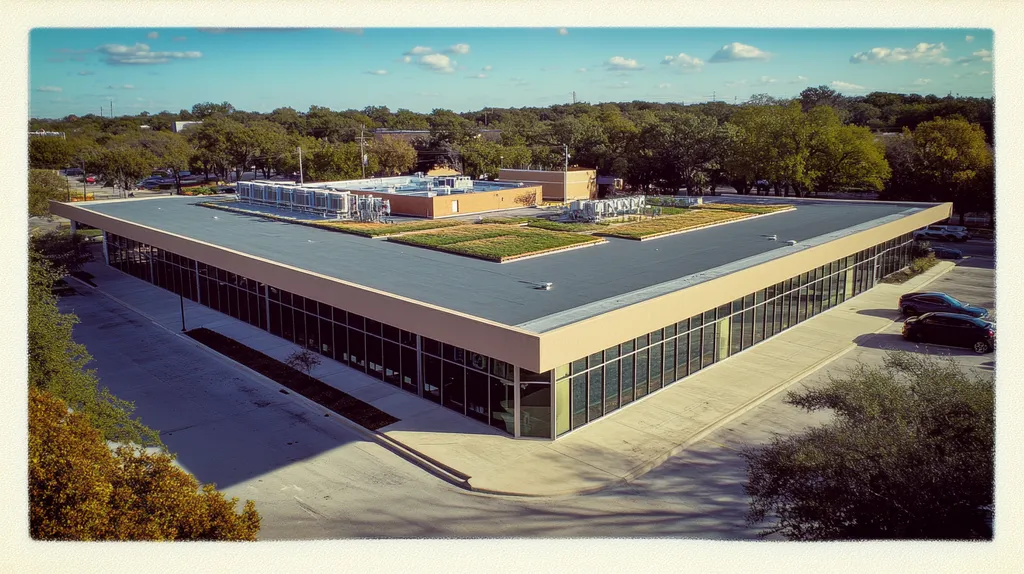In the industrial roofing sector, over $3.5 billion is wasted annually due to improper recoating practices and misguided repair attempts. Nearly one-third of commercial roof failures stem from incorrect assumptions about repainting over existing coatings.
Property owners and facility managers face mounting pressure to extend roof lifespans while controlling costs, yet common misconceptions continue to drive costly mistakes.
This comprehensive analysis examines six critical aspects of industrial roof repainting, from widespread myths to evidence-based solutions that protect valuable roofing investments.
SECTION 1: COMMON MISCONCEPTIONS
When it comes to industrial roofing, misconceptions surrounding the practice of repainting existing coatings can result in significant financial losses. In fact, poor surface preparation and misunderstandings about product compatibility are responsible for around 30% of roof failures. To protect their investments, property owners and facility managers need to clear up these myths and make informed decisions. This section outlines three prevalent misconceptions that can greatly influence roofing outcomes.
Myth: Repainting Over Existing Coatings is Always Safe
A common myth suggests that repainting over existing coatings is always a safe and effective choice. Unfortunately, that is not the case. Not all roof coatings work well together, and mixing incompatible materials can lead to problems like peeling and blistering.
If the existing coating is already deteriorating or damaged, adding a new layer can only exacerbate the situation, reducing overall protection and leading to higher repair costs down the line.
It is crucial to conduct a thorough assessment of the roof’s current condition before proceeding with any repainting. This examination should include checking for moisture levels, wear patterns, and signs of degradation in the current coating.
By neglecting this important evaluation, property owners risk facing serious issues in the future, such as leaks and the need for complete roof replacement.
Belief: New Coatings Replace Old Ones Completely
Another widespread belief is that new coatings can completely replace old ones, essentially providing a clean slate. While new coatings add layers of protection, they do not resolve underlying issues present in older systems.
Structural weaknesses or existing damage must be addressed prior to applying a new coating. If left uncorrected, these problems can cause greater disasters later, as new layers may only mask the real issues.
Moreover, some existing coatings require specific conditions for compatibility, which must be understood beforehand to avoid complications. Embracing this misconception can lead to wasted resources and disruptions in facility operations.
Property owners should prioritize a comprehensive understanding of their roofing systems to ensure effective roof maintenance.
Assumption: DIY Repairs are Sufficient
Many facility managers operate under the assumption that DIY repairs are adequate for industrial roofs. While some minor tasks may be manageable in-house, this approach often neglects essential elements that necessitate professional expertise.
Without the right training, DIY repairs can easily worsen existing issues rather than resolve them.
Professional roofing contractors possess specialized tools, high-quality materials, and the knowledge to accurately evaluate roofing systems. Relying on untrained individuals can result in uneven applications and adherence problems, increasing the risk of future leaks and damage.
By outsourcing repair tasks to qualified professionals, property owners can ensure their roofs receive the attention and care necessary for durability and performance.
SECTION 2: PRACTICAL IMPLICATIONS
Deciding to repaint over existing coatings on industrial roofs is not a choice to be taken lightly. Ignoring the potential impact on roof integrity can lead to dire consequences, including premature failures, expensive repairs, and safety concerns. Research shows that unmaintained roofs can lose up to 50% of their lifespan. This section dives into the practical ramifications of repainting, addressing critical themes such as roof integrity, water resistance, and energy efficiency.
Impact on Roof Integrity and Longevity
The longevity and structural integrity of a roof are paramount for property owners. Repainting over damaged coatings can trap moisture, accelerating deterioration. Poor adhesion of new layers may cause flaking and peeling, ultimately shortening the roof’s effective lifespan.
Industry best practices emphasize conducting comprehensive inspections prior to repainting. If the underlying material shows damage, repainting could worsen these issues, leading to structural failures that are costly to fix.
Proper surface preparation is critical for success. A thorough cleaning and priming ensure that new coatings bond effectively. Neglecting this step could severely compromise the roof’s integrity, resulting in significant repair expenses later.
The long-term consequences of overlooking roof assessments reiterate the necessity for skilled evaluations before initiating any repainting project.
Effects on Water Resistance and Leak Prevention
Water resistance is essential for the performance of any industrial roof. While repainting can provide a protective waterproof layer, it may also trap moisture if not executed properly. This moisture buildup can lead to unnoticed leaks and water damage that escalate over time.
In areas with high rainfall, the risks become even more pronounced. A poorly applied repaint can precipitate roof failure, disrupting business operations. Ensuring that new coatings are compatible with existing materials is crucial for maintaining optimal water resistance.
Selecting coatings designed with superior moisture barriers enhances leak prevention capabilities. Some products allow trapped moisture to escape, preserving the roof’s structure. This detail is vital during product selection and application planning.
A meticulous approach to planning and execution is essential to enhance water resistance during the repainting process.
Influence on Energy Efficiency and Maintenance
Energy efficiency plays a significant role in industrial roofing decisions. A new, reflective coating can significantly reduce heat absorption, which leads to lower cooling expenses. However, repainting without regard for the coating color or type may diminish these energy-saving benefits.
Studies indicate that lighter reflective coatings can lower roof temperatures by up to 30%. This reduction not only boosts energy efficiency but also helps mitigate the urban heat island effect. Proper selection of the coating type is vital for maximizing these advantages.
Moreover, maintenance implications are critical. Regular repainting fosters a continuous cycle of costs and labor. Investing in high-quality, durable coatings initially can decrease maintenance frequency and extend the roof’s lifespan, ultimately leading to significant savings.
By considering energy efficiency and maintenance factors, property owners can make informed decisions that yield both environmental and financial benefits.
SECTION 3: COST OF MISINFORMATION
The ramifications of misinformation in the repainting of industrial roofs can be staggering. Industry studies indicate that over 30% of premature roof failures stem from incorrect coating practices. Such misguided decisions not only lead to inflated short-term costs but also create significant long-term financial burdens. Property owners and facility managers must grasp these financial implications to protect their investments.
Financial Consequences of Premature Repairs
Premature repairs create a false sense of security for property owners. When roofs are inaccurately assessed, expensive actions are undertaken without addressing the underlying problems. Consequently, property owners face unexpected costs that can quickly spiral out of control.
For example, poorly applied coatings can allow water to infiltrate, leading to significant damage to the underlying structure. Repair bills for such unseen damage can far exceed the initial savings from inadequate assessments.
Additionally, spending on temporary fixes reduces available budgets for proactive maintenance, creating a cycle of escalation in repair needs and costs. Conducting thorough evaluations and planning can help property owners sidestep these financial traps.
Hidden Costs of Incorrect Coating Applications
Incorrect coating applications not only increase the risk of immediate roof failure but also introduce hidden costs that may go unnoticed until severe damage occurs. For instance, leaks resulting from faulty coatings might not be apparent for months or even years.
This delay can lead to restoration costs that catch property owners by surprise. Complicated insurance claims may also arise from inadequate roofing decisions made earlier.
Moreover, selecting the wrong products can significantly shorten the lifespan of the roof. This decreases the time between necessary replacements, leading to mounting expenses faster than anticipated.
Besides financial implications, poor roofing can disrupt business operations, resulting in tenant dissatisfaction and potential losses.
Long-Term Expenses Due to Neglect
Neglecting proper repainting can culminate in long-term financial consequences that outweigh initial costs. As a roof’s integrity declines over time, energy costs escalate, resulting in higher operating expenses.
For instance, an unmaintained roof may suffer from thermal degradation, reducing energy efficiency and leading to skyrocketing utility bills.
Additionally, a deteriorating roof can impose liabilities, such as employee injuries or damage to inventory. These risks further strain operational budgets and impact overall profitability.
Ultimately, neglecting proper roofing practices complicates future renovations and expansions. These compounded challenges can deter investment and limit opportunities for growth.
SECTION 4: REALITY CHECK
Regular roof inspections are not just a good practice; they are essential for safeguarding industrial properties. Neglecting this crucial step can lead to significant repair costs or premature roof failure. Research indicates that as many as 30% of roofing issues could be avoided through routine evaluations. By understanding the importance of these assessments, property owners can maintain roof integrity and extend its lifespan.
The Importance of Regular Roof Inspections
Regular inspections are the first line of defense against unexpected roofing issues. They help detect early signs of wear, such as cracks or peeling, that might otherwise go unnoticed. Identifying these problems early can save property owners thousands of dollars in future repairs.
Additionally, inspections provide valuable insights into the condition of existing coatings. These assessments can indicate if a roof is still performing well or requires immediate action. By taking a proactive approach, property owners minimize operational disruptions and enhance safety within the facility.
Frequent evaluations also support compliance with manufacturer warranties, which often require regular maintenance for coverage. Ignoring these stipulations can lead to denied claims, adding further financial strain.
In summary, regular inspections are crucial for effective roof management. They empower property owners to make informed decisions, ensuring longevity and performance.
The Role of Professional Assessment and Application
Professional assessment and application are key to the success of repainting efforts. Property owners often underestimate the complexity involved in evaluating and preparing surfaces for new coatings. Inaccurate assessments can result in improper applications that compromise roof integrity.
Experts possess knowledge of best practices for surface preparation, including cleaning and priming. These preparatory steps are essential for ensuring that new coatings adhere properly and perform as intended. Neglecting preparation can lead to premature peeling or wear, requiring costly repairs sooner than anticipated.
Engaging professionals also helps mitigate safety risks associated with the painting process. Working on commercial and industrial roofs often involves navigating heights and handling hazardous materials. Experienced roofing contractors follow safety protocols that protect both workers and the facility.
Therefore, hiring professionals elevates the outcome of repainting while minimizing risks and liabilities for property owners. This expertise represents a crucial investment in the roof’s longevity and effectiveness.
Deterioration of Coatings Over Time
While coatings are designed to be durable, they naturally deteriorate over time due to external factors. Environmental conditions, such as UV radiation, rainfall, and extreme temperatures, can significantly wear down roofing surfaces. This degradation undermines the protective capabilities of the roof.
Property owners should not assume that a newly applied coat will last indefinitely. Most manufacturers provide lifespan estimates for coatings, and it’s essential to adhere to these guidelines. Regular evaluations help identify the right timing for reapplication, thus avoiding leaks and structural damage.
Neglecting signs of coating deterioration can lead to severe structural issues. Water intrusion can cause ongoing damage to insulation and structural support, escalating repair costs. Timely attention to coating wear helps prevent larger problems and saves money in the long run.
In conclusion, understanding how coatings deteriorate informs repainting strategies. Regular inspections and professional evaluations are critical for effective roof maintenance and longevity.
SECTION 5: EVIDENCE-BASED ALTERNATIVES
Repainting industrial roofs without proper preparation can lead to significant and unexpected costs. Studies show that failing to address deteriorating coatings can reduce roof lifespans by as much as 50%. Property owners and facility managers are faced with critical decisions regarding roof maintenance. Understanding evidence-based alternatives can enhance longevity, cost-efficiency, and overall roof performance. This section delves into the benefits of high-quality coatings, the importance of preventive maintenance programs, and best practices for successful application and repair.
Benefits of Using High-Quality Coatings
High-quality coatings significantly enhance both the durability and performance of industrial roofs. These advanced products offer superior weather resistance, UV protection, and flexibility, providing a better alternative to standard coatings. With quality coatings, property owners can anticipate an extended roof lifespan and lower maintenance costs.
Innovative coatings also boost energy efficiency by reflecting sunlight and minimizing heat absorption. This leads to lower cooling expenses for facilities, underscoring their long-term value. Some coatings can lower roof surface temperatures by up to 40% during the hottest summer months.
Furthermore, high-quality coatings exhibit excellent adhesion qualities, which helps to prevent delamination. A strong bond with existing substrates reduces the risk of future repairs, enhancing overall asset preservation. Consequently, investing in premium coatings is a strategic choice for facility managers and property owners seeking long-term savings.
Advantages of Preventive Maintenance Programs
Establishing preventive maintenance programs is essential for prolonging the life of industrial roofs. Regular inspections and timely repairs allow for minor issues to be detected before they escalate into significant problems. Proactive maintenance can cut overall roofing costs by up to 30%, according to industry research.
These programs ensure routine cleaning, debris removal, and checks for potential leaks or damage. By implementing a structured maintenance schedule, facility managers can keep roofs functioning at their best year-round while improving energy efficiency and performance.
Additionally, preventive maintenance extends the service life of roofing systems, reducing the frequency of costly replacements. By taking this proactive approach, property owners not only enhance durability but can also gain peace of mind regarding their investments.
Best Practices for Coating Application and Repair
Employing best practices during coating application can dramatically affect overall roof performance. Preparing the surface properly is crucial for achieving good adhesion, which includes thorough cleaning, repairing damage, and applying primers as needed to establish a solid foundation.
Timing plays an important role as well. Ideal conditions for application typically occur when temperatures range between 50°F and 80°F, which favor the curing process of coatings. Property owners should plan their projects to achieve the best outcomes.
The equipment and techniques used during the application also matter. Proper sprayers, rollers, or brushes ensure an even application and reduce waste. Trained professionals should handle the application process, as their expertise helps avert common mistakes.
Finally, regularly inspecting applied coatings will help identify any imperfections or failures early on. Promptly addressing issues can save property managers significant time and money while maintaining roof integrity over the long term.
SECTION 6: TEST AND VERIFY
Ensuring the longevity and effectiveness of a repainted industrial roof begins with rigorous testing and verification. Property owners risk costly failures if they overlook vital steps to confirm coating adhesion and durability. Research indicates that nearly 30% of coatings fail due to improper application or lack of assessment, leading to premature roof replacements. Therefore, proactive evaluation methods are essential to safeguarding investments and ensuring optimal performance.
Methods for Testing Coating Adhesion and Durability
Testing the adhesion of a roof coating is crucial for determining its long-term effectiveness. A widely used method is the tape test, where an adhesive tape is applied to the coated surface and then removed. If the coating remains on the tape, adhesion is deemed acceptable; if it peels away, the bond may be inadequate.
Another important technique is the pull-off test, which quantifies the force needed to detach the coating from the substrate. This method provides objective data about bond strength and can highlight weaknesses that visual inspections might overlook.
Evaluating the coating’s weather resistance is also essential to predict how well it will perform under variable environmental conditions. Laboratory tests that simulate extreme temperatures and UV exposure can help assess durability before real-world application.
By utilizing these methods, property owners can gain a comprehensive understanding of the coating’s performance and address any potential issues prior to further application.
Verification of Coating Performance in Various Conditions
Ongoing verification of a coating’s performance is critical to ensure it can withstand environmental challenges. Regular monitoring allows property managers to swiftly address issues before they escalate into significant problems. For instance, UV exposure can accelerate the degradation of certain coatings, particularly in sunny regions.
Conducting inspections after significant weather events is essential to identify early signs of wear and tear. Facilities managers should carefully assess the coating for bubbling, cracking, or discoloration, which may indicate underlying adhesion or durability issues.
Amending maintenance schedules to incorporate these inspections can drastically extend the life of the coating. Some experts recommend biannual assessments, especially in areas prone to severe weather conditions.
By staying attentive to performance metrics, property owners can avoid substantial costs related to unplanned repairs or complete roof replacements.
Importance of Periodic Checkups and Upkeep Procedures
Periodic checkups are vital for maintaining the performance of repainted roofs. Regular inspections not only help in early problem detection but also provide opportunities for preventative maintenance. This proactive approach can significantly reduce the likelihood of expensive repairs.
Implementing a structured maintenance plan is crucial. Property owners should maintain records of all inspections and maintenance tasks, creating documentation that aids future assessments and warranty claims.
Additionally, routine cleaning of the coated surface is necessary to remove debris and pollutants that may deteriorate the coating. Soft brushes and mild cleaning solutions can effectively preserve the integrity of the paint while minimizing wear.
By prioritizing these practices, property owners can ensure that their investments in roofing coatings yield prolonged lifespans and enhanced protection for their buildings.
The Bottom Line
With over $3.5 billion wasted annually on improper industrial roof recoating, the stakes for making informed decisions have never been higher.
Property owners who ignore proper testing, assessment, and application procedures face up to triple the repair costs compared to those following evidence-based practices.
The research clearly demonstrates that successful industrial roof repainting requires professional evaluation, high-quality materials, and systematic maintenance programs.
By dispelling common myths and implementing verified best practices, facility managers can extend roof lifespans by 40-50% while significantly reducing long-term costs.
The path forward demands a shift from reactive repairs to proactive maintenance, supported by regular inspections and documented testing procedures.
FREQUENTLY ASKED QUESTIONS
Q. Is repainting an industrial roof always safe?
A. Not necessarily. Repainting over existing coatings may lead to complications if materials are incompatible. It is essential to assess the current condition of the roof, including checking for moisture and damage, before proceeding with any repainting to avoid potential pitfalls.
Q. How does repainting affect industrial roof integrity?
A. Repainting can compromise roof integrity if done improperly. Inadequate surface preparation may trap moisture or lead to poor adhesion, significantly shortening the roof’s lifespan. A thorough assessment is crucial before repainting to ensure adherence and overall structural stability.
Q. What financial impacts can misinformation about roofing lead to?
A. Misinformation can lead to premature repairs that incur unexpected costs. Applying incorrect coatings or failing to address underlying issues can escalate repair expenses quickly. It is vital for property owners to base decisions on accurate information to avoid financial pitfalls.
Q. Why are regular inspections important for industrial roofs?
A. Regular inspections help identify wear and potential issues early, allowing property owners to make necessary repairs before they escalate and lead to costly damage. These assessments maintain roof integrity and often comply with warranty requirements for ongoing protection.
Q. What are evidence-based alternatives to simple repainting?
A. Alternatives include using high-quality coatings designed for enhanced durability and energy efficiency, as well as establishing preventive maintenance programs. These strategies help to prolong roof life and maintain performance better than basic repainting.
Q. How should I verify the performance of a new coating?
A. Verify performance by testing coating adhesion and monitoring for any signs of wear, such as bubbling or cracking. Implementing regular inspections and maintenance checks can help identify issues early and mitigate long-term damage.
Q. What risks are associated with DIY projects for industrial roofs?
A. Engaging in DIY repairs can lead to improper applications and worse existing roof issues. Without professional expertise, property owners may miss crucial checks or make errors that can lead to significant structural damage and additional costs.

